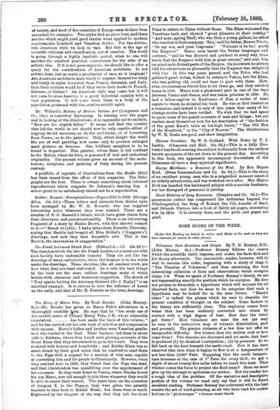SOME BOOKS OF THE WEEK.
[Under this Heading we intend to notice such Hooks of the week as have not been reserved for review in other forms.] Volcanoes: their Structure and Origin. By T. G. Bonney, D.Sc. (John Murray. 6s.) —Professor Bonney follows the course which the scientific habit imposes, and states his facts first and his theory afterwards. The unscientific reader, however, will do well to reverse this order, beginning with a study of chap. 6, "The Theories of Volcanoes," and then examining the very interesting collection of facts and observations which occupies chaps. 1-6. When we speak of Professor Bonney's theory, we are not representing exactly the position which he occupies. He does not profess to formulate a hypothesis which will account for all observed facts, nor does he seem to be sanguine that such a hypothesis may be looked for in the near future. " Mental chaos" is indeed the phrase which he uses to describe the present condition of thought on the subject. Some factors in the theory are sufficiently clear. The explosion comes from water that has been suddenly converted into steam by contact with a high degree of heat. How does the water get there ? Most volcanoes are near the sea (as may be seen in the instructive map of volcanic distribution, past and present). The greater distance of a few does not offer an insuperable difficulty. But whence does the molten rock or lava come from ? Two theories arediscussed and set aside, that heat is produced (1) by chemical combination ; (2) by pressure. So we fall back on the heat beneath the earth-crust. Now it has been observed that lava when it begins to flow is at a temperature of not less than 2,000° Fahr. Supposing that the earth tempera- ture increases at the rate of 1° Fahr. for every 64 ft., we get a depth of about twenty-five miles before we reach this heat. Then whence comes the force to project the fluid mass? Here we must give up the attempt to epitomise our author. But the reader has a rough idea of the problem. Of the narrative and descriptive portion of the volume we need only say that it will be found excellent reading. Professor Bonney has cultivated with the best results the art of word-picturing, as all who have read his contri- butions to "picturesque" volumes must know.






































 Previous page
Previous page